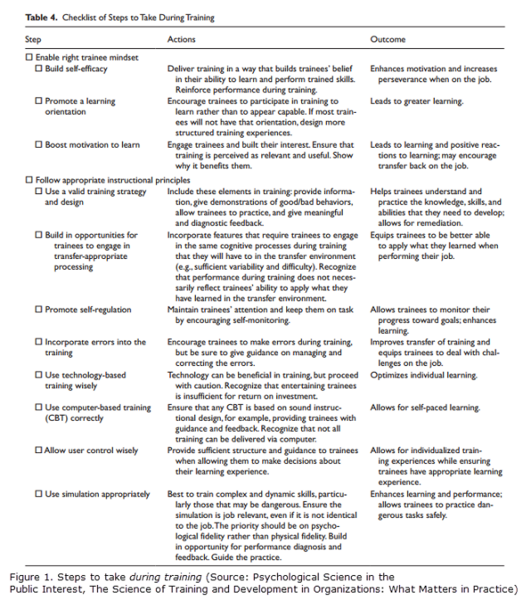ATD Blog
Science of Learning 101: What Research Says Matters Most During Training
Tue Aug 11 2015

Last month, I began a discussion of "The Science of Training and Development in Organizations: What Matters in Practice" by Eduardo Salas and fellow authors. This paper tells us, in very clear terms, that “decisions about what to train, how to train, and how to implement and evaluate training should be informed by the best information science has to offer.” The authors used meta-analyses (statistical methods for contrasting and combining results from multiple research studies) to help us see the best ways to design, deliver, and implement training so our outcomes are as good as possible. What’s more, it allows us to apply the science of learning to our own organization.
In my post, I reviewed things I felt were most interesting about what we need to do before training, primarily needs analysis and setting a learning climate. This month, I’ll pick out some of the issues I felt were most important from the meta-analyses about the most effective practices during training.
Figure 1 (Table 4 from the research) offers a checklist of steps to take during training to ensure maximum effectiveness.

Individual Characteristics
The authors begin with a discussion of how people bring individual characteristics to the learning environment and how these characteristics influence training outcomes. For instance, self-efficacy is what a person believes about his or her own abilities, and goal-orientation is how a person thinks about, interprets, and behaves in learning environments. Meanwhile, motivation is the effort, interest, and persistence that a person puts into learning.
Because these characteristics significantly influence learning, the top portion of Figure 1 lists what the research says L&D practitioners must do to influence these characteristics. The research also discusses how to help people with different orientations to training succeed. For example, it says that those who want to take greater responsibility for their own learning processes should be given that freedom while those who need more structure may need more help. This made me consider how we might facilitate additional mentoring as needed.
Currently, we tend to treat everyone the same, but according to research, this is not the best way to succeed. This makes sense with adults, just as it makes sense with children.
Training Strategies
A good training strategy, claim the authors, provides correct information, demonstrates desired behaviors, creates adequate practice opportunities, and provides good feedback, and allows for remediation. Research tells us that that a great deal of learning occurs through practice and feedback components during instruction. So practice must have timely, constructive, actionable, task-focused, and diagnostic feedback. The delivery approach should enhance learning and transfer to the workplace.
Unfortunately, a great deal of e-learning, especially, provides mostly instructional content with minimal practice elements. We often provide poor feedback and little remediation, and the practice elements we provide are not anything like what people find at work. Clearly, L&D practitioners need to rethink what we are doing.
Technology Issues
Some research suggests that training costs are the same for technology-based training as for traditional classroom training. Reductions in training staffing and travel are often offset by investments in technologies. More importantly, not all training needs are best addressed with technology-based training approaches.
One of the failures of technology-based environments is when people are unable to successfully navigate and use high learner-controlled environments. At first glance, this may seem surprising, but recent skills research shows that too many people do not have the digital skills needed for today’s workplace. Salas and the other authors want organizations to examine if these digital environments provide enough structure or guidance for their workers to learn as expected.
Next month, I’ll continue with what The Science of Training and Development in Organizations: What Matters in Practice found in the meta-analyses of what works after training. As always, please let me know in the Comments below what you plan to do with this information. I very much want to provide you with actionable information.
Further Reading
Salas, E., Tannenbaum, S.I., Kraiger, K and Smith-Jentsch, K.A. (2012). The Science of Training and Development in Organizations: What Matters in Practice, Psychological Science in the Public Interest, 13 (2), pp. 74-101. 42.
